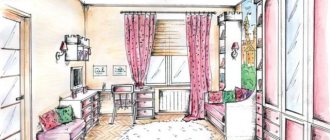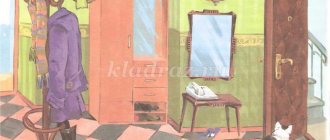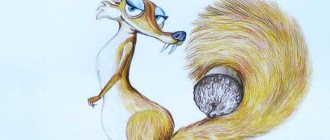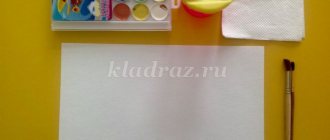Summary of the drawing lesson “Furniture and household appliances for little gnomes” in the senior group
Summary of the drawing lesson “Furniture and household appliances for little gnomes” in the senior group
Target:
Expanding and deepening ideas about furniture, its purpose, details and parts; the materials from which it is made.
Tasks.
Clarify, expand and activate the vocabulary on the topic “Furniture. Appliances".
Develop the ability to independently choose the color scheme of paints that corresponds to a joyful mood.
Develop color perception, improve fine motor skills of fingers and hands.
Arouse a positive response to the results of your creativity.
Progress of the lesson
Organizing time.
Guys, today a balloon flew to us, and there was a letter attached to it. Here it is.
"Hello guys!
Little gnomes from a fairyland are writing to you. We're in trouble. The evil witch turned our furniture and household appliances into sand. But she has bewitched the inhabitants of our country, and no one remembers what kind of furniture and household appliances there are. We sleep on the floor, we also eat on the floor, and our plates are also on the floor. Help us ".
Educator.
Well, guys, let's help the little gnomes?
Children's answers
What kind of furniture do you know?
Children's answers
Educator
. And what does a person need for even greater convenience?
Children's answers
(Appliances)
Educator.
List the household appliances you know.
Children's answers
Conversation about furniture, household appliances and their parts.
Educator.
Guys, tell me why we need furniture? (chair, table, etc.)
Children's answers
Educator.
Guys, do you know what parts the furniture has?
(Show corresponding pictures)
The table has a tabletop and legs.
A chair has legs, a seat, a back.
The chair has a soft back and seat, armrests, and legs.
The bed has a base, mattress, headboard, footboard (foot end).
The sofa has a soft long back and seat, armrests, legs.
The cabinet has walls, shelves, doors, legs.
The chest of drawers has walls, drawers, and doors.
Educator.
Guys, why do we need household appliances? (vacuum cleaner, iron, etc.)
Children's answers
Educator.
What parts do household appliances have?
(Show corresponding pictures)
The washing machine has a drum, a door, and a control panel.
The iron has a heating surface, a control button and a cord with a plug.
The vacuum cleaner has a body, a dust bag, a hose, and attachments for the hose.
Physical education minute.
Ball game: “Which one?” Which? Which? Which?"
Educator.
I will name the furniture and ask you a question, and you will answer me.
For example.
What kind of chair? Wooden, comfortable, hard, tall. Etc.
Vacuum cleaner, what? Plastic, powerful. Etc.
Educator.
Well, guys, you know everything about furniture and household appliances. How can we help the little gnomes?
"Photographer"
Didactic task:
stimulate visual memory, clarify the names of household appliances.
Material:
household appliances or their image (10-15 pcs.), screen.
Exercise. An adult shows a set of objects, asks the children to name them, then summarize them in one word. Then he hides all the objects and asks him to name them all again.
As they are named, objects are taken out from behind the screen so that the child does not repeat himself. The one who can name all the objects at once wins.
"Listen and Draw"
Target:
teach children to communicate freely while making a joint drawing.
Material:
paper, felt-tip pens (pencils).
Game actions:
reflect in the drawing the understanding of a polysemantic word.
Progress of the game
The teacher names a word, for example “pen”, which has several meanings. The players’ task is to draw this word in all its diversity.
While working, children should be able to comment on their drawings and communicate freely.
Drawing objects with the word “leg” (on another sheet of paper) is done in a similar way.
"Finish the sentence"
Target:
activate words denoting household appliances; develop coherent speech; exercise in establishing cause-and-effect and spatio-temporal relationships.
Complete the sentence with pictures:
I'm cleaning the carpet... (with a vacuum cleaner). I wash clothes in... I listen to the news on...
I'm ironing... I'm watching a movie... I'm looking for new information in...
I whip cream with... I store food in... I sew a dress with...
I'm talking to a friend on... I'm taking a picture of our family...
Abstract of GCD for drawing “Household Appliances”
Sofya Zemlyakova
Notes on drawing "Household Appliances" Teacher Zemlyakova S.L.
• Learn to draw rectangular objects;
• Develop the ability to place an image on a sheet of paper, draw large ;
• Systematize children's ideas about household appliances ;
• Encourage safe handling of electrical appliances .
Equipment: Pinocchio character, illustrations of televisions; album sheets, colored pencils, simple pencils.
Notes on Drawing in the preparatory group “Techniques for Fixies”
Baranova Yulia Alekseevna
Notes on Drawing in the preparatory group “Technique for Fixies”
Lesson notes for the preparatory group . " Technique for fixies "
1 consolidate drawing with a pencil and paint over them
2. Develop creativity.
3. Cultivate perseverance.
4. Activate children's speech.
Materials and equipment: presentation, sheet of paper, gouache paints, brushes, simple pencil, eraser, water jar.
“What first, what then?”
Target:
consolidate knowledge of the stages of the labor process in creating tools and electrical appliances; clarify ideas about the variety of materials; enrich children's ideas about the work of adults, its collective nature, the interconnection of many professions; cultivate a caring attitude towards household appliances and tools.
Material:
cards for building a logical chain of several links.
Game rules:
choose the right cards, fold them and explain the logic of constructing the chain.
Game actions:
arrange the pictures in a logical chain.
Progress of the game
The adult shows an envelope with a letter in which Dunno asks the children to tell about how certain objects appeared. He sent us pictures of items that interested him.
Option 1. An adult shows children pictures of a finished object (i.e., the last link of a logical chain) and offers to arrange pictures in a row that tell how this object was made, in order from beginning to end. Then the children make up a short story: “What was what? What became what?
Option 2. “What happened before and what will happen after?”
An adult gives children pictures of tools: saw, screwdriver, mixer, meat grinder, vegetable slicer, grater, floor brush, beater, etc.
Children are asked to remember what this object was before (people used different sticks instead of a screwdriver before), what was invented from it later? (The screwdriver was turned into an electric screwdriver, drill, etc.)
“Who needs what for work?”
Target:
encourage children to identify and classify objects that make work easier at work and at home (tools, devices); enrich children's understanding of the work of adults.
Material:
pictures depicting various objects, as well as objects that facilitate human work at work and at home; chips.
Game rules:
For a correct and complete answer, the child receives a chip. The one who gets the most chips wins.
Game actions: choose a suitable picture, name the object, explain its purpose, how to operate with it.
Progress of the game
The adult says that Dunno decided to help Samodelkin decompose. But he, of course, does not know what anyone needs for work. Let's help Dunno!
Option 1. An adult lays out all the pictures on the table, shows the one that depicts a person of some profession, and invites the participants in the game to choose pictures depicting objects necessary for the work of a person of this profession. Children take turns taking pictures, naming the object, and telling why it serves a person.
Option 2. Then pictures are laid out on the table depicting objects that make people’s work easier in everyday life. An adult describes one of the objects. The child who is the first to guess the item matches it with pictures depicting people of suitable professions. It is necessary to tell why all these people need this item.
A child can also be the leader.
On the topic: methodological developments, presentations and notes
Notes on artistic and creative development in the senior group. "Home helpers (household appliances)"
develop the ability to answer questions, solve riddles; clarify knowledge about various types of household appliances; learn to be creative when working with plasticine.
Lesson summary on the topic “Our assistants are electrical appliances” for the presentation “Our assistants are electrical appliances”
Life safety lesson for older children.
Summary of direct educational gaming activities TOPIC: “Our helpers in the house”
Goal: To summarize children’s knowledge about household electrical appliances, their purpose and rules of use.
Project “Robot assistants in the home”
An article on introducing children of primary preschool age to the topic “Electrical safety and our helpers in the house.”
The article indicates GCD with children of primary preschool age on electrical safety, preliminary work with children. Introducing parents how to introduce children to home helpers.
Our helpers in the house
Summary of GCD in the senior group.
Calendar planning in the junior group “Our helpers and enemies at home”
Thematic week in the junior group on home safety rules.
Source
Summary of the lesson "Electrical appliances" in the middle group
Olga Yanshina
Summary of the lesson “Electrical Appliances” in the middle group
Goal: To summarize children’s knowledge about household electrical appliances , their purpose and rules of use. Develop mental activity and curiosity. To instill in children a sense of careful handling of electrical appliances . Cultivate attention, sensitivity, responsiveness. Enrich vocabulary, develop coherent speech. Foster frugality and save energy, water, light, protect nature, etc.
Equipment, tools and materials: Cards with images of electrical appliances , riddles, illustrations “Rules for using electrical appliances ”
, fairy-tale character Simka.
Preview:
Summary of the integrated lesson “Our Helpers in the House”, using non-traditional drawing materials.
Goal: developing an understanding of household appliances, their purpose, and rules of use.
Objectives: to form knowledge about household appliances, develop cognitive activity, interest in the objects around us; develop creative abilities; develop the ability to perform teamwork; develop speech, expand vocabulary.
Equipment: audio recording from the cartoon “Fixies”, theatrical screen, toy household appliances, cards with images of household appliances, items for the game “Sort Out the Products”, template “TV”, paints, brush, jar for water, palette, sponges for drawing.
Preliminary work: reading fiction, coloring, looking at illustrations, drawings with different household appliances, conversation.
Educator: Hello, Guys! Today we have an unusual activity, today we will visit a cartoon! (music from the cartoon plays.)
Simka enters: Hello, Guys! Do you recognize me? My name is Simka.
Educator: Hello, Simka! Guys, that means we are already in the cartoon! Which one? (Fixies). Everything is correct, only Simka is sad for some reason, what happened?
Simka: I lost Nolik and I can’t find him, guys, can you help me find him? Yes!
Educator: Simka, take some rest for now
Let's do some exercises together (Let's do exercises for a minute.)
Get up quickly, smile
Sat down - stood up, sat down - stood up
Educator: Guys, do you know where the cartoon characters live? (vacuum cleaner, hair dryer, computer, washing machine, stove, microwave, iron, fan, mixer, etc.) That's right! How to call these items in one word? Appliances. (In your hands is a picture of household appliances.)
Educator: That means we need to look for Nolik in household appliances.
Simka: he left us hints - tasks. Can we handle it together, guys? Yes!
(Household appliances are arranged in groups, each appliance has a task, before the task briefly - why we need this device, then move on to another device.)
We approach the first table: there is an iron on it, we look for Nolik, but we only find the task: Do exercises for the tongue.
Educator: we didn’t find it, let’s move on!
Second table: teapot, we are looking for Nolik, but we only find the task: convert from singular to plural.
Iron - irons, kettle - ... vacuum cleaner - ... refrigerator - ... TV -... telephone -... tape recorder -... etc.
Third table: hairdryer, we are looking for Nolik, but we only find the task: the game “Find a Pair”. I give each person a picture, everyone must find a pair.
8. Fan – a person who is hot;
Fourth table: refrigerator (briefly - what is it for), we are looking for Nolik, but we only find the task: the game “Sort out the products” (on the table there are objects (an apple, a book, a car, a potato, a lemon, bread, a cucumber, a doll, a cube, a ball ) you need to sort these items into their places: food in the refrigerator, the rest in the basket).
Educator: Guys, now in our group we have everything: a refrigerator, an iron, a hairdryer, and a kettle, but it seems that something is missing, we don’t have a TV!
(There is no TV in the group, but there is a TV template on the board)
Educator: What should we do with him? And no clue! This is probably a new task from Nolik! Guys, what can you watch on TV? (Movies, films, TV shows, etc.) Do they show us the weather forecast? It’s cloudy outside, but I really want the sun. Guys, what do you think is good weather? (Sunny, warm, no clouds or rain.) To be warm, we need the sun. Shall we draw? What color is the sun? Yellow! But if we are now in a cartoon, does that mean it should be an unusual color, like orange? Guys, look, what color paints are on our table? (yellow and red) and no orange. Where do you think we can get it? Mix colors! Mix paints on the palette. A palette is a plate with small indentations; it is needed in order to mix colors and get new ones!






